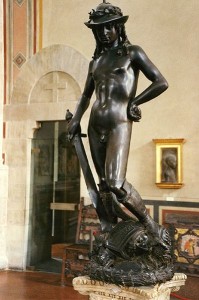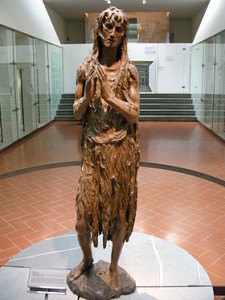Donatello, Frontrunner of the Renaissance
Posted on November 1st, 2013 by Anna in Uncategorized | No Comments »
One of the most underappreciated figures of the Italian Renaissance, Donato di Niccolò di Betto Bardi, better known as Donatello, was a crucial figure in the early development of Italian art. Donatello was born in Florence around the year 1386, and he received his first artistic training at the hands of Lorenzo Ghiberti, a renowned goldsmith. His first big commission was for a statue of St. John the Baptist, and in Donatello’s work the shift of artistic expression from the stylized idealism of the late Gothic Mannerist style to a more organic and emotional humanist style is evident.
As Donatello developed into an independent sculptor, mostly working on images and bas-reliefs of saints commissioned by churches, his work started to contain a stronger emphasis on naturalism and the beauty of the human figure. In the year 1430, Cosimo de’ Medici, the top artistic patron at the time, commissioned from Donatello what is now the famous David, the very first free-standing nude sculpture since the times of the Roman Empire, which has been described as “so naturalistic that it must have been made from life.” Intriguing and startling art critics for centuries, Donatello’s David has been interpreted as a parable of reason and virtue triumphing over brutality, and as a symbol of the artist’s homoerotic tendencies due to the subject’s dreamy, effeminate posture and physique.
Moving from Florence to Rome, and then from Rome to Padua, Donatello continued to work on statues and carvings for various cathedrals and palazzos, both religious and pagan-themed. In 1443 he cast a life-sized bronze equestrian statue of Erasmo da Narni, a dramatic and glorious monument the likes of which hadn’t been seen since classical times, and which was placed in the center of the town plaza. The equestrian Erasmo quickly inspired copycat monuments all across Italy as Donatello’s fame grew. He created many religious works for the Basilica of St. Anthony, including a bronze crucifix, a statue of the Madonna, and carved allegories depicting Adam and Eve in the Garden of Eden.
When he returned to Florence, Donatello was rightly perceived to be a master of his craft; as he continued to create bronze reliefs and statues in his characteristically free, intense style, he also trained young sculptors who went on to become notable artists themselves, such as Bartolomeo Bellano and Bertoldo di Giovanni. His final work, reliefs of Christ Before Pilate and Christ Before Caiphus, were left purposely unfinished, a technique that was popular at the time to underscore intense spiritual tension of a scene. When Donatello died in 1466, he was buried in the Basilica of San Lorenzo in an elevated tomb beside his patron, Cosimo de’ Medici.
While Donatello’s work isn’t as celebrated as some of other great Italian artists, his early influence on naturalism in sculpture and emotional expression was crucial in leading to greater developments in artistic expression over the next few centuries. His attention to both physical beauty and anatomic perfection in his statues helped drive the movement away from the rigid medieval style of sculpting, and his nonconventional and intimate depiction of Biblical characters paved the way for greater freedom of interpretation during the later Renaissance.






